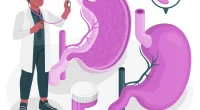Biliary tract disease encompasses a range of conditions affecting the gallbladder, bile ducts, and associated structures. These conditions often include disturbances in bile flow, leading to symptoms like jaundice (yellowing of the eyes and skin), lower stomach pain, and digestive issues like indigestion and nausea.
Common causes include infections, gallstones, inflammation (like cholangitis or cholecystitis), and congenital abnormalities. Management varies depending on the specific condition but may involve dietary changes, medications, and in some cases, surgical interventions to alleviate symptoms and prevent complications.
Symptoms
Biliary tract disease can manifest through different symptoms, often depending on the specific condition affecting the gallbladder or bile ducts. One of the hallmark symptoms is abdominal pain, typically felt in the upper right quadrant of the abdomen.
This pain can range from mild discomfort to intense, sharp sensations and may worsen after meals, especially those high in fat. Accompanying this pain, individuals might experience gas, bloating, and a feeling of fullness, contributing to digestive discomfort.
Another prominent symptom of biliary tract disease is jaundice, characterized by yellowing of the skin and whites of the eyes. This occurs when bile flow is obstructed or impaired, leading to the build-up of bilirubin—a pigment normally excreted through bile.
Jaundice often presents alongside dark urine and pale stools, reflecting altered bilirubin levels. Additionally, individuals with biliary disease may suffer from nausea, vomiting, and generalized itching, stemming from the buildup of bile components in the bloodstream. These symptoms can differ in seriousness and duration depending on the underlying cause and progression of the disease, highlighting the importance of timely medical evaluation and appropriate management.
Causes
The common causes of biliary tract disease:
- Gallstones: Hardened deposits of bile components that can block bile ducts.
- Infections: Bacterial infections like viral infections or cholangitis affecting the bile ducts.
- Inflammation: Conditions like cholecystitis (gallbladder inflammation) or primary sclerosing cholangitis (scarring and chronic inflammation of bile ducts).
- Congenital Abnormalities: Birth defects affecting the structure or function of the bile ducts.
- Biliary Strictures: Narrowing of the bile ducts due to scarring, often post-surgical or from chronic inflammation.
- Biliary Dyskinesia: Dysfunction of the gallbladder or sphincter of Oddi affecting bile flow.
- Biliary Tumors: Both malignant and benign tumors affecting the gallbladder or bile ducts.
- Autoimmune Disorders: Conditions like autoimmune hepatitis or primary biliary cholangitis affecting bile ducts.
- Trauma: Physical injury to the abdomen or bile ducts leading to complications.
These causes can result in various symptoms and require specific treatments depending on the underlying condition.
Treatment
The treatment of biliary tract disease depends largely on the underlying cause and seriousness of symptoms. For conditions like gallstones causing intermittent pain or blocking bile flow, treatment often involves managing symptoms through dietary changes and medicines to dissolve stones or alleviate discomfort.
In cases where gallstones persist or cause severe signs like inflammation or infection, surgical removal of the gallbladder (cholecystectomy) may be suggested. This procedure is typically minimally invasive and effectively resolves symptoms while allowing normal bile flow to continue.
For other forms of biliary tract disease like infections or inflammatory conditions like cholangitis or primary sclerosing cholangitis, treatment focuses on antibiotics to control infections, anti-inflammatory medications, and sometimes immunosuppressants to manage inflammation.
In cases where there are narrowing or strictures in the bile ducts, procedures like endoscopic retrograde cholangiopancreatography or surgical interventions may be necessary to widen or bypass the narrowed segments, improving bile flow and relieving symptoms. Long-term management often involves regular observation, dietary modifications to decrease fat intake, and ongoing medical care to prevent complications and maintain bile duct function.
Diagnosis
Diagnosing biliary tract disease typically starts with a thorough medical history and physical examination to assess symptoms like jaundice, abdominal pain, and digestive disturbances. Laboratory tests play a crucial role, including liver function tests (LFTs) to assess bilirubin levels and liver enzymes, which can indicate bile duct blockage or liver dysfunction.
Additionally, imaging studies such as ultrasound, MRI, or CT scan, may be used to visualize the gallbladder, bile ducts, and liver for signs of gallstones, inflammation, or structural abnormalities. These imaging techniques help in confirming the presence of conditions like cholecystitis (inflamed gallbladder) or cholangitis (inflamed bile ducts).
In cases where imaging is inconclusive or further detail is required, more specialized procedures like endoscopic retrograde cholangiopancreatography or magnetic resonance cholangiopancreatography may be performed.
These procedures allow direct visualization and sometimes intervention in the bile ducts, enabling biopsies or the removal of gallstones. Biopsies can help diagnose conditions like primary sclerosing cholangitis or biliary tumors, providing critical information for treatment planning. Overall, the diagnostic approach to biliary tract disease is comprehensive, aiming to detect the underlying cause accurately to guide appropriate management and improve patient outcomes.
Complications
Complications of biliary tract disease can be serious and potentially life-threatening. They include:
- Pancreatitis: Inflammation of the pancreas due to blockage of the pancreatic duct by gallstones.
- Cholangitis: Infection of the bile ducts, which can lead to sepsis if not promptly treated.
- Gallbladder Empyema: Infected gallbladder with pus accumulation, requiring urgent surgical intervention.
- Biliary Stricture: Narrowing of the bile ducts, which can lead to bile duct obstruction and liver damage.
- Gallstone Pancreatitis: Inflammation of the pancreas due to a gallstone passing through the common bile duct.
- Gallbladder Cancer: Long-standing inflammation or gallstones can increase the chance of developing cancer in the gallbladder.
- Liver Damage: Prolonged obstruction or infection can lead to cirrhosis or liver damage over time.
- Septic Shock: Serious infection spreading through the bloodstream, potentially leading to multiple organ failure and death if untreated.
Prevention
Preventing biliary tract disease involves several key measures. Maintaining a healthy weight through a nutritious diet and regular exercise can decrease the chance of developing gallstones, a common precursor to many biliary conditions.
Eating a diet rich in fruits, vegetables, and fiber, and limiting saturated fats and cholesterol can also help prevent gallstone formation. Avoiding rapid weight loss diets and promoting gradual, sustainable weight loss strategies can further mitigate risk.
For individuals with a family history of biliary disease or gallstones, regular medical check-ups and discussions with healthcare providers about risk factors and preventive measures are advisable.
Summary
Biliary tract disease encompasses conditions like gallstones, infections, and inflammation affecting the gallbladder and bile ducts. Symptoms include jaundice, abdominal pain, and digestive issues, often requiring imaging and blood tests for diagnosis. Treatment varies from medications and dietary changes for gallstones to surgical interventions for severe cases like cholecystitis or bile duct obstructions.
Complications can range from pancreatitis and cholangitis to liver damage and cancer, emphasizing the importance of early diagnosis and management. Prevention strategies include maintaining a healthy weight, a balanced diet low in saturated fats, and regular medical check-ups, particularly for those at higher risk due to family history.









